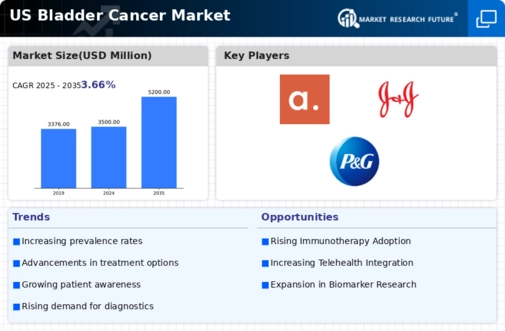Rising Incidence Rates
The bladder cancer market is experiencing growth due to the increasing incidence rates of bladder cancer in the US. According to the American Cancer Society, approximately 81,000 new cases are expected in 2025, indicating a rise in awareness and diagnosis. This trend is likely to drive demand for innovative treatment options and diagnostic tools within the bladder cancer market. As the population ages, the risk of developing bladder cancer increases, further contributing to the market's expansion. The growing number of patients necessitates advancements in therapies and supportive care, which may lead to increased investments in research and development. Consequently, stakeholders in the bladder cancer market are focusing on developing targeted therapies and personalized medicine to address the unique needs of this patient population.
Increased Funding for Research
The bladder cancer market is benefiting from increased funding for research initiatives aimed at understanding the disease better and developing new treatment options. Government agencies and private organizations are allocating substantial resources to bladder cancer research, with funding levels reaching over $100 million annually. This financial support is crucial for advancing clinical trials and exploring novel therapeutic approaches. Additionally, collaborations between academic institutions and pharmaceutical companies are fostering innovation in the bladder cancer market. As research progresses, new insights into the biology of bladder cancer may lead to breakthroughs in treatment strategies, ultimately improving patient outcomes and driving market growth.
Growing Awareness and Education
The bladder cancer market is positively impacted by growing awareness and education regarding the disease. Campaigns aimed at educating the public about risk factors, symptoms, and the importance of early detection are gaining traction. Organizations such as the Bladder Cancer Advocacy Network are playing a pivotal role in disseminating information, which may lead to earlier diagnoses and increased patient engagement. As awareness rises, more individuals are likely to seek medical attention, contributing to the overall growth of the bladder cancer market. This heightened awareness also encourages healthcare providers to prioritize bladder cancer screening and management, further driving demand for innovative treatment solutions.
Advancements in Treatment Modalities
The bladder cancer market is significantly influenced by advancements in treatment modalities. Recent developments in targeted therapies and immunotherapies have shown promising results in improving patient outcomes. For instance, the introduction of novel agents such as immune checkpoint inhibitors has transformed the treatment landscape, leading to higher response rates and prolonged survival. The market is projected to reach approximately $5 billion by 2026, driven by these innovative therapies. Furthermore, the integration of precision medicine is enabling healthcare providers to tailor treatments based on individual patient profiles, enhancing efficacy. As a result, pharmaceutical companies are increasingly investing in research to develop next-generation therapies, which is likely to propel the bladder cancer market forward.
Regulatory Support for New Therapies
The bladder cancer market is experiencing favorable regulatory support for the approval of new therapies. The US Food and Drug Administration (FDA) has streamlined the approval process for innovative treatments, particularly those addressing unmet medical needs. This regulatory environment encourages pharmaceutical companies to invest in the development of novel therapies for bladder cancer. The expedited approval pathways, such as Breakthrough Therapy Designation, are likely to accelerate the availability of effective treatments to patients. As a result, the bladder cancer market is expected to witness an influx of new products, enhancing treatment options and improving patient outcomes.














Leave a Comment